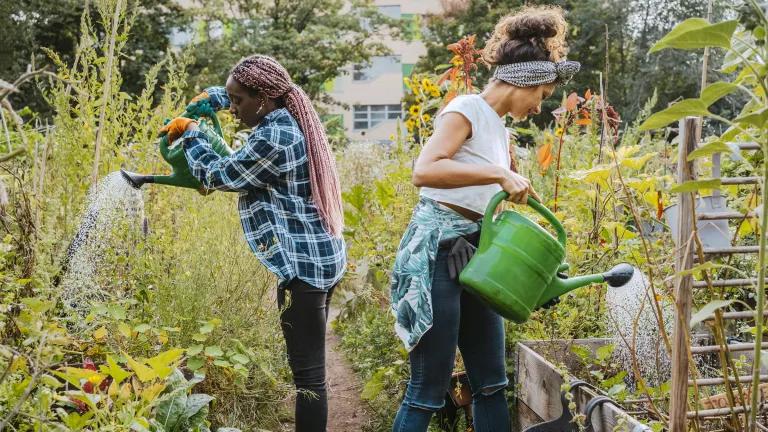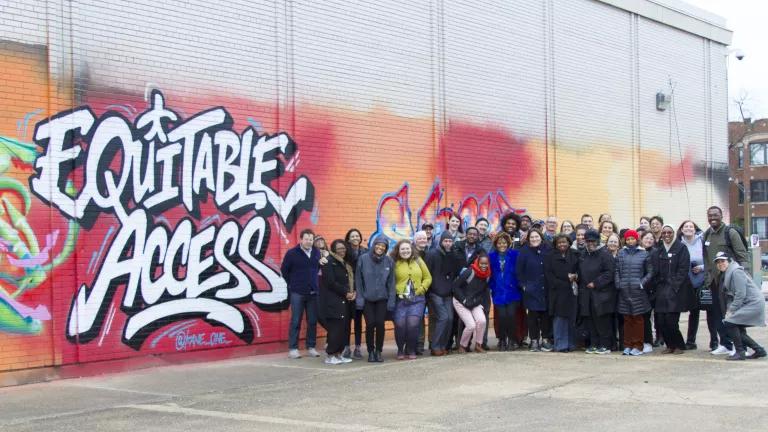What Does It Mean to Have Healthy People and Thriving Communities?

Let’s think for a minute about the world in which we want to live—the one we inhabit and depend on every single day. It’s the one in which our water is safe, our products are free of deadly chemicals, our homes and families are protected from storms and flooding, our energy is clean, and everyone has access to adequate housing and opportunity.
That world is something we can agree on—and work toward, regardless of politics. It’s a world in which we exercise our human right to clean air and water, and to live free of environmental harm. That vision is also at the heart of the work in our program, Healthy People & Thriving Communities.
Everyday Environmentalism
Some on our team recently dubbed us the “environmentalists of everyday life,” and that sounds about right. We’re proud to be everyday environmentalists if it means fighting for a just, sustainable, and socially equitable world in which people have a meaningful voice in their health and well-being.
You may have been seeing more lately about the links between social justice, climate and the environment. In fact, there isn’t a way to improve the environment on a large scale without understanding the relationships between climate action, poverty eradication, public health, reducing inequality and sustainable development.
This was spelled out clearly in last year’s Intergovernmental Panel on Climate Change (IPCC) Fifth Assessment Report (AR5), which warned that urgent and systemic changes are needed to keep global temperatures—on the rise due to a warming planet—at 1.5 degrees Celsius, or 2.7 degrees Fahrenheit above pre-industrial levels.
In its opening chapter, the report states that “equity, poverty alleviation and sustainable development” are each a critical component of addressing climate change. It also devotes an entire chapter to the need for establishing sustainable development, poverty eradication and reducing inequalities as the central factors in meeting the global temperature goals.
At the U.S. federal level, proposals such as the Green New Deal and other plans also set goals to achieve net-zero greenhouse gas pollution through a fair and just transition, with social and economic justice at the core of the solution. Americans, after all, do overwhelmingly support environmental action.
Meeting this climate, health, and equity imperative means massively expanding public transit, saving energy, securing clean water, eliminating pollution and toxic chemicals, preparing for disasters, revitalizing communities with walkable streets and enhanced natural water systems, reducing food waste, and preventing low-income communities and people of color from bearing a disproportionate burden from climate change effects and pollution.
We embrace these principles in this new program, in everything from issues around wasting excessive amounts of food and toxics in consumer products to reducing lead and other toxins in water, as well as advocating for energy efficiency in buildings and low-income housing, green transportation and financing, and community-led sustainable revitalization and green infrastructure.
Our Work
How have these principles played themselves out in our work?
Just ask the family of Kevin Hartley, a young Nashville man who died suddenly after being overcome by the fumes of a commonly sold paint stripper that has been banned in other countries since 2011 but remains legal in the United States. In 2018, NRDC successfully pressured major U.S. retailers to stop selling the chemical.
Or talk to Olga McKissic of Louisville, KY, whose home has flooded five times from increasingly strong storms but who can’t relocate because of a broken flood insurance program that NRDC is trying to help fix. Or Darcelle Pettis of Charlottesville, VA., who had to choose between paying her electric bill and buying food before NRDC’s EEFA energy-efficiency program got involved.
Below are outcomes of these and other HP&TC projects within the last year in our efforts on behalf of clean water, eliminating toxics, building resilient communities, mitigating flooding, and furthering a resilient and equitable world.
Health, Water Quality and Food
- Court Forces EPA to Ban Toxic Insecticide Chlorpyrifos. In August 2018, a court ordered the EPA to finalize its ban on the neurotoxic pesticide chlorpyrifos, which has been linked to learning difficulties and developmental delays in children. NRDC first petitioned the EPA for a ban in 2007.
- Major Retailers Take Toxic Paint Strippers off their Shelves. Lowe’s, Home Depot, Wal-Mart, Amazon and seven other retailers have committed to removing the deadly paint stripper methylene chloride from their shelves, after NRDC campaigns aimed at the retailers. NRDC is increasing pressure on the Trump Administration to finalize a federal ban on the substance, which is linked to several deaths.
- Chicago protected. NRDC advocated successfully for new local and federal protections in Chicago, requiring monitoring of the neurotoxic manganese and lead in the air and an investigation into contaminated soils near communities in the industrial corridor.
- Flint and State of Michigan Tackle Lead in Drinking Water. In June 2018, the state of Michigan finalized the strongest rules on lead in drinking water in the country. This comes after NRDC’s litigation in the scandal over the quality of drinking water in Flint.
- Newark Suit Over Water. In June, NRDC and our community clients, the Newark Education Workers Caucus, a group of public school educators, sued the City of Newark and state and city officials for violations of the federal Safe Drinking Water Act. Newark’s water system has exceeded the federal lead action level for four consecutive six-month monitoring periods and its lead levels are among the highest recorded by a large water system in the United States in recent years.
- New York City Commitment on Water. NRDC’s advocacy helped commit New York City to spending $1 billion in additional funds on pollution-prevention and watershed protection initiatives to safeguard the nation’s largest municipal water supply.
- McDonalds Commits to Slashing Antibiotics in Meat Supply. After nearly a year of behind-the-scenes advocacy by NRDC, fast food giant McDonald’s committed in December to reducing the use of antibiotics across its vast global beef supply by 2021—a major step in the fight to curb one of our greatest public health threats, bacterial resistance to antibiotics. This is the first major commitment of its kind by a burger chain or any mega beef retailer.
- Compostable Utensils in Schools. NRDC helped the Urban School Food Alliance launch compostable utensils in two major school districts in New York and helped the Alliance grow to 10 major districts, serving 3.3 million kids.
- Food Waste Recovery. The City of Baltimore released the Baltimore Food Waste Recovery Strategy—which announced the city’s partnership with NRDC and The Rockefeller Foundation on the cities-based Food Matters Project. This work helps prevent food from going to waste and rescues surplus food for food-insecure residents.
Flooding, Water Infrastructure and Transportation
- Congestion Pricing. New York City is set to become the first U.S. metropolitan area to incorporate congestion pricing—a fee for cars entering certain zones during high-traffic periods—after strong advocacy by NRDC and other groups. The move sets the stage for other cities to join the effort to reduce crippling traffic and lower pollution.
- Homeowner Assistance. The Government Accountability Office initiated a study of FEMA-financed buyouts of flood prone homes, prompted by proposed bipartisan legislation developed with the help of NRDC, which pointed out it takes an average of 5 ½ years for homeowners to get assistance to relocate to higher ground.
- Back to the Well. In May, NRDC released Go Back to the Well, a report that showed how many states are failing to adequately invest their own resources to help communities meet their water infrastructure needs.
- Flood Disclosure Report Card. In August, NRDC released a flood disclosure report card that showed which states require home buyers to be fully informed of past flood damages and flood risks. The report card highlighted how the majority of states fail to ensure that home buyers are informed of a property’s flood history.
Housing and Buildings
- City Energy Project (CEP). In December, the City of Fort Collins, CO, approved a benchmarking ordinance to achieve energy and water reductions through the Building Energy and Water Scoring program, and the San Jose, CA, City Council approved the Energy and Water Building Performance Ordinance to report energy and water usage in large commercial and multifamily buildings. The City Energy Project is a joint initiative of NRDC and the Institute for Market Transformation and has made huge strides in energy efficiency in the largest buildings in 20 cities and beyond. Its new resource library is now online.
- Energy Efficiency for All (EEFA). Overall more than 73,000 homes have been made healthier and more affordable through energy efficiency and other improvements thanks to the work of EEFA partner organizations. This benefits an estimated 140,000+ individuals, and EEFA has secured nearly $500 million in confirmed and estimated new funding for energy efficiency improvements in affordable multifamily homes.
- Class Action Suit in New York. In November, a federal judge approved an amended class action settlement with the New York City Housing Authority that NRDC and partners filed on behalf of community residents. The agreement includes important new protections for residents, including oversight from independent mold and data experts, and appointment of an ombudsperson who can order relief for individual tenants.
Working with Communities
- American Cities Climate Challenge. (ACCC) NRDC is a founding partner with Bloomberg Philanthropies of the American Cities Climate Challenge, launched in June to coincide with the first anniversary of the U.S. withdrawal of the Paris Climate Agreement. The $70 million initiative accepted 25 cities into a two-year program to help them meet carbon reduction goals.
- Strong, Prosperous, and Resilient Communities Challenge (SPARCC). In December, SPARCC convened hundreds of stakeholders to advance "investment without displacement” solutions and address issues of inequality, improve the social determinants of health, and advance environmental benefits that help create strong, just and resilient communities.
- Constitution Pipeline. NRDC helped block the construction of the Constitution Pipeline, a fracked gas pipeline that would have harmed hundreds of communities, hundreds of trout streams and wetlands, and cleared nearly 500 acres of forest in New York State.
- Help for Parks in New York State. NRDC helped solidify $300 million in the New York State budget for the Environmental Protection Fund—with more money at record levels for parks in financially challenged communities. NRDC also helped obtain for the first-time New York State funding of $10 million for the Catskills Park.
California at the Forefront
- Storm Water Projects are Funded. With a broad coalition, we helped win Passage of Measure W in Los Angeles County, a $300 million a year parcel tax to fund storm water projects like green streets, rain gardens and drinking water infiltration basins. A percentage of the tax will be devoted to funding projects in disadvantaged communities.
- Preparing for Drought. New state laws championed by NRDC set standards for the efficient use of water in California homes and landscapes and require cities, rural communities and farms to better prepare for the longer and more intense droughts climate change will bring.
- Litigation Succeeds. NRDC successfully sued EPA to require stormwater permits that limit pollution discharges from commercial, industrial and institutional (CII) facilities in Los Angeles County's most urbanized watersheds.
- A Settlement in Use of Water in Landscaping. In September 2018, NRDC reached a successful settlement of a lawsuit against Pasadena, CA, over the city’s failure to comply with state regulations to prevent excessive water use in new residential and commercial landscapes. The terms of the settlement have implications for hundreds of cities across the state, and last month, a similar case in Murrieta, CA, was just settled under similar terms.
- Changes in a Car-driven Culture. After four years of analysis and input from stakeholders, including NRDC, California is beginning to look at significant changes in the way the state measures transportation’s impact on the environment, taking into account the environmental benefits of sustainable transportation and denser housing.
Green Finance
- Center for Market Innovation (CMI). The Center for Market Innovation within NRDC facilitated the launch of the Washington, D.C., Green Bank as well as advancing Green Bank creation in Mexico and Chile in partnership with NRDC international programs. CMI also strengthened the most comprehensive resource center for green banks at greenbanknetwork.org.
Where We Live
Sometimes it’s hard to determine where climate and environmental advocacy come in when we’re carrying on with our everyday lives. But you can see from this work that it is at the ground level—where we live.
It’s all part of our program’s focus on people—as communities nationwide face the growing climate-related challenges like flooding, harsh temperatures and record-breaking storms.
And, people will continue to be at the center of our work as we prepare in the coming years for potentially more intense climate change effects—especially for those most vulnerable—and fight for change with new evidence of the urgent need for effective action.




